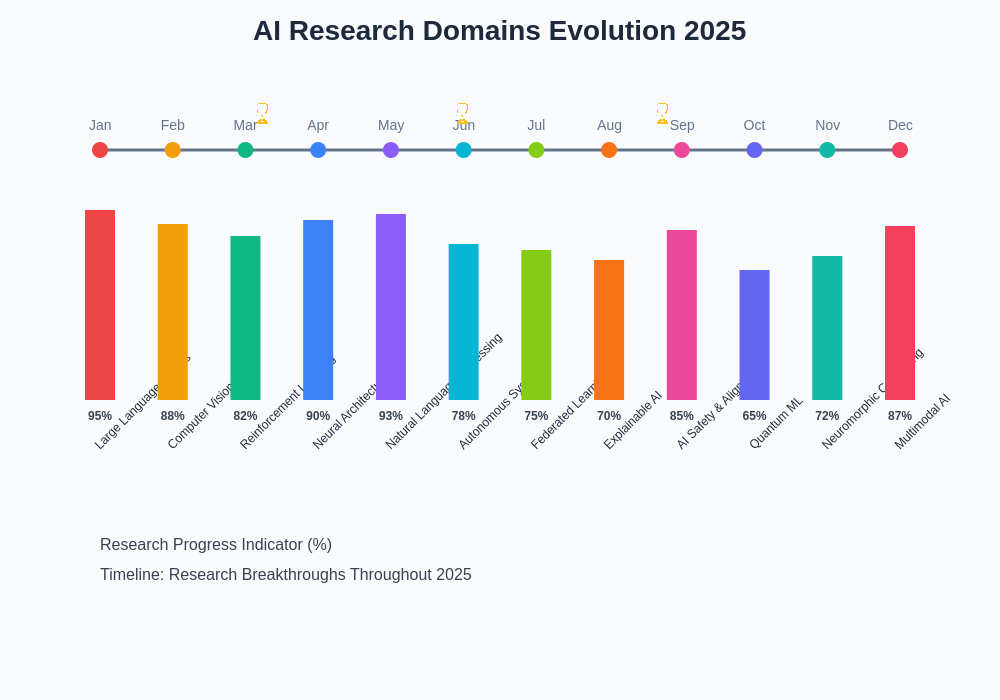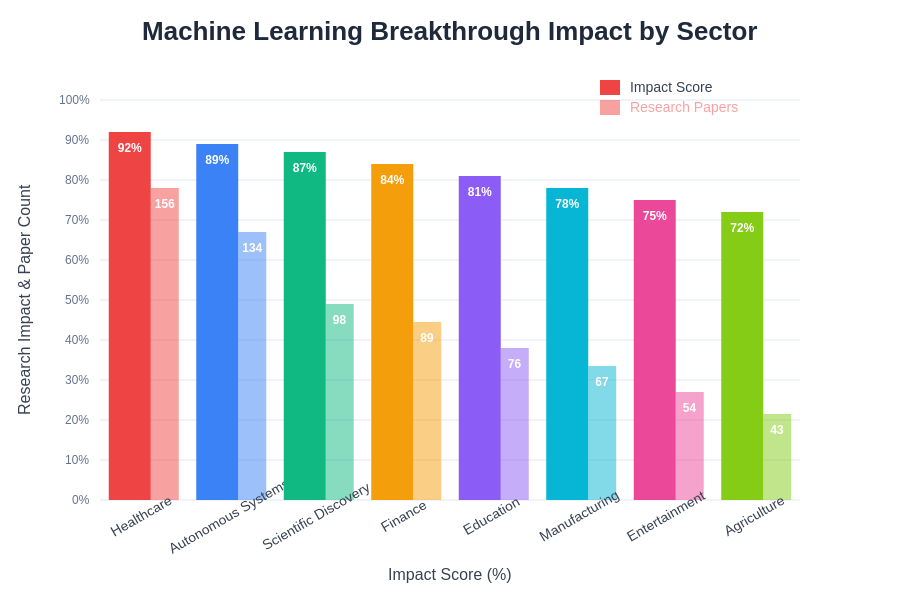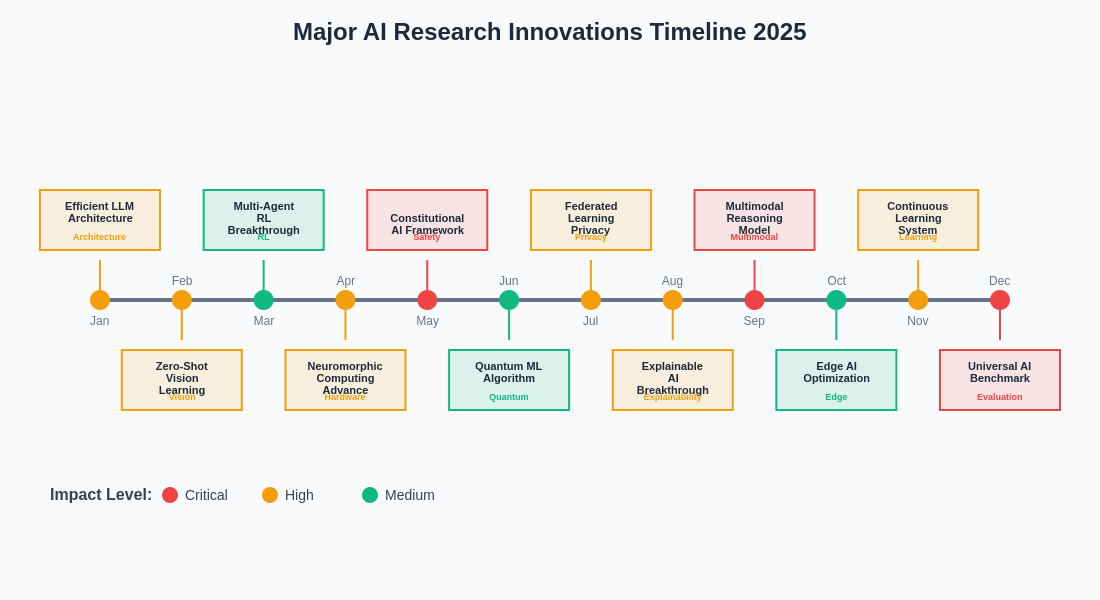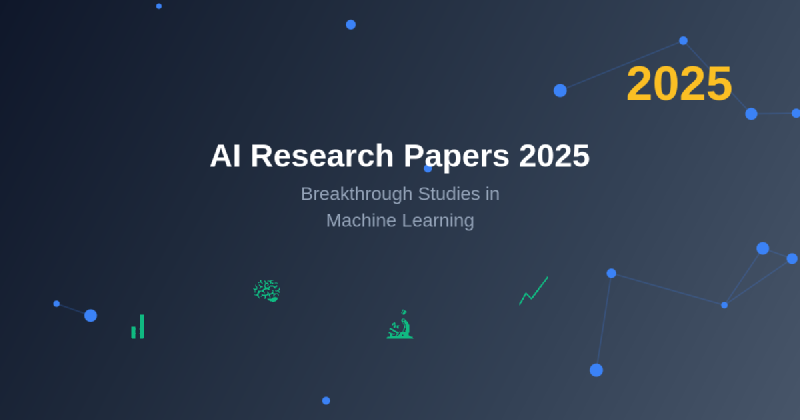The year 2025 has emerged as a watershed moment in artificial intelligence research, marked by groundbreaking discoveries that are fundamentally reshaping our understanding of machine learning capabilities and potential applications. The scientific community has witnessed an unprecedented surge in innovative research papers that challenge existing paradigms while opening new frontiers in computational intelligence, autonomous systems, and human-AI collaboration.
Explore the latest AI trends and developments to stay informed about cutting-edge research breakthroughs that are transforming the landscape of artificial intelligence. The convergence of theoretical advances with practical implementations has created a fertile ground for revolutionary discoveries that promise to redefine how we interact with and benefit from artificial intelligence systems.
Revolutionary Advances in Large Language Models
The landscape of large language models has experienced transformative changes throughout 2025, with researchers achieving remarkable breakthroughs in model efficiency, reasoning capabilities, and multimodal understanding. Leading research institutions have published seminal papers demonstrating significant improvements in parameter efficiency, where models with fewer parameters achieve superior performance compared to their predecessors through innovative architectural designs and training methodologies.
One of the most significant developments has been the emergence of hybrid reasoning architectures that combine symbolic logic with neural network processing, enabling language models to perform complex mathematical reasoning, logical deduction, and causal inference with unprecedented accuracy. These advances have been documented in comprehensive research papers that detail novel attention mechanisms, improved tokenization strategies, and revolutionary training techniques that dramatically reduce computational requirements while enhancing model capabilities.
The integration of real-time learning capabilities into large language models represents another major breakthrough, allowing these systems to continuously adapt and improve their performance based on user interactions and environmental feedback. Research papers published in 2025 have demonstrated how reinforcement learning from human feedback can be implemented more efficiently, resulting in models that better align with human values and preferences while maintaining robust performance across diverse applications.
Groundbreaking Developments in Computer Vision
Computer vision research in 2025 has achieved remarkable milestones in object recognition, scene understanding, and visual reasoning capabilities that surpass human performance in numerous specialized domains. Breakthrough research papers have introduced novel convolutional architectures and transformer-based vision models that demonstrate exceptional accuracy in medical imaging, autonomous vehicle navigation, and robotic perception systems.
The development of few-shot and zero-shot learning techniques in computer vision has revolutionized how machines learn to recognize and categorize visual information with minimal training data. Research studies have shown that advanced meta-learning algorithms can enable vision systems to rapidly adapt to new visual categories and environments, significantly reducing the data requirements for training effective computer vision models.
Enhance your AI research with Claude’s advanced capabilities for comprehensive analysis and synthesis of complex research papers across multiple domains of artificial intelligence and machine learning. The intersection of computer vision with natural language processing has yielded particularly impressive results, with multimodal models achieving unprecedented performance in visual question answering, image captioning, and visual reasoning tasks.
Breakthrough Studies in Reinforcement Learning
Reinforcement learning research in 2025 has witnessed extraordinary advances in sample efficiency, exploration strategies, and multi-agent coordination that have expanded the practical applications of these techniques across numerous industries. Pioneering research papers have introduced innovative algorithms that significantly reduce the number of interactions required for agents to learn optimal policies, making reinforcement learning more viable for real-world applications where data collection is expensive or time-consuming.
The development of hierarchical reinforcement learning frameworks has enabled the creation of agents capable of learning complex, long-horizon tasks through the decomposition of objectives into manageable sub-goals. Research studies have demonstrated how these hierarchical approaches can be applied to robotics, game playing, and resource management problems, achieving superior performance compared to traditional flat reinforcement learning architectures.
Multi-agent reinforcement learning has experienced remarkable progress with the introduction of novel coordination mechanisms and communication protocols that enable groups of agents to collaborate effectively on complex tasks. Research papers have shown how these advances can be applied to traffic management, distributed computing, and collaborative robotics, where multiple intelligent agents must work together to achieve common objectives while adapting to dynamic environments.

The evolution of AI research domains throughout 2025 demonstrates the interconnected nature of breakthrough discoveries, where advances in one area catalyze innovations across multiple fields of study, creating a synergistic effect that accelerates overall progress in artificial intelligence.
Revolutionary Neural Architecture Innovations
Neural network architecture research in 2025 has produced transformative designs that dramatically improve computational efficiency while enhancing model performance across diverse applications. Breakthrough research papers have introduced sparse attention mechanisms, dynamic routing algorithms, and adaptive computation techniques that enable neural networks to automatically adjust their processing complexity based on input difficulty and available computational resources.
The emergence of neural architecture search techniques powered by evolutionary algorithms and reinforcement learning has automated the discovery of optimal network designs for specific tasks and hardware constraints. Research studies have demonstrated how these automated design processes can discover architectures that outperform human-designed networks while requiring significantly less computational overhead during inference.
Neuromorphic computing research has achieved significant milestones in 2025, with papers demonstrating how brain-inspired architectures can achieve remarkable energy efficiency while maintaining competitive performance on complex machine learning tasks. These advances have particular importance for edge computing applications where power consumption and computational efficiency are critical constraints.
Breakthrough Advances in Natural Language Processing
Natural language processing research in 2025 has achieved unprecedented capabilities in language understanding, generation, and cross-lingual transfer that approach human-level performance across numerous linguistic tasks. Revolutionary research papers have introduced novel pre-training objectives, improved tokenization methods, and advanced fine-tuning strategies that enable language models to better capture semantic meaning, pragmatic understanding, and cultural context.
The development of multilingual models capable of seamlessly transferring knowledge across languages has opened new possibilities for global communication and information access. Research studies have shown how these models can perform high-quality translation, cross-lingual question answering, and multilingual text generation while maintaining consistency and accuracy across diverse linguistic contexts.
Conversational AI research has experienced remarkable progress with the introduction of dialogue systems that can maintain coherent, contextually appropriate conversations across extended interactions. Breakthrough papers have demonstrated how these systems can exhibit personality consistency, emotional intelligence, and adaptive communication styles that enhance user engagement and satisfaction.
Discover comprehensive AI research capabilities with Perplexity for in-depth exploration of research papers and scientific literature across all domains of artificial intelligence and machine learning. The integration of commonsense reasoning into natural language processing systems has yielded particularly impressive results, enabling AI systems to better understand implicit information, make logical inferences, and engage in more natural human-like communication.
Pioneering Research in Autonomous Systems
Autonomous systems research in 2025 has achieved remarkable breakthroughs in navigation, decision-making, and environmental adaptation that have expanded the practical deployment of autonomous technologies across numerous industries. Groundbreaking research papers have introduced novel perception algorithms, improved path planning techniques, and advanced control systems that enable autonomous vehicles, drones, and robots to operate safely and efficiently in complex, dynamic environments.
The development of swarm intelligence algorithms has revolutionized how multiple autonomous agents can coordinate their actions to achieve collective objectives while adapting to changing conditions and unexpected obstacles. Research studies have demonstrated successful applications in disaster response, environmental monitoring, and large-scale logistics operations where coordinated autonomous systems provide significant advantages over individual agents.
Safety and reliability research has produced comprehensive frameworks for validating and verifying autonomous system behavior under diverse operating conditions. Breakthrough papers have introduced formal verification methods, simulation-based testing protocols, and real-world validation techniques that ensure autonomous systems can operate safely and predictably in mission-critical applications.
Revolutionary Developments in Federated Learning
Federated learning research in 2025 has addressed fundamental challenges in privacy-preserving machine learning, enabling collaborative model training across distributed data sources while maintaining strict privacy guarantees. Innovative research papers have introduced advanced cryptographic techniques, differential privacy mechanisms, and secure aggregation protocols that allow organizations to benefit from collective intelligence without compromising sensitive data.
The development of personalized federated learning algorithms has enabled the creation of models that can adapt to individual user preferences and local data distributions while benefiting from global knowledge sharing. Research studies have shown how these personalized approaches can achieve superior performance compared to centralized training while maintaining privacy and reducing communication overhead.
Cross-device federated learning has experienced significant advances with the introduction of efficient communication protocols and adaptive aggregation strategies that enable effective learning across heterogeneous device populations with varying computational capabilities and connectivity patterns.

The measurable impact of machine learning breakthroughs across different sectors demonstrates the transformative potential of 2025’s research advances, with particularly significant improvements in healthcare, autonomous systems, and scientific discovery applications.
Breakthrough Studies in Explainable AI
Explainable artificial intelligence research in 2025 has made substantial progress in developing methods that provide interpretable insights into AI decision-making processes while maintaining model performance and accuracy. Revolutionary research papers have introduced novel visualization techniques, attribution methods, and causal analysis frameworks that enable users to understand how AI systems arrive at their conclusions and predictions.
The development of counterfactual explanation methods has provided powerful tools for understanding AI behavior by showing how changes to input features would affect model outputs. Research studies have demonstrated how these techniques can be applied to fairness auditing, model debugging, and regulatory compliance in high-stakes applications such as healthcare, finance, and criminal justice.
Interactive explanation systems have emerged as a significant research area, with breakthrough papers showing how humans and AI systems can collaborate to refine explanations, identify model limitations, and improve overall system performance through iterative feedback processes.
Advanced Research in AI Safety and Alignment
AI safety research in 2025 has achieved critical breakthroughs in developing robust methods for ensuring AI systems behave safely and align with human values across diverse deployment scenarios. Pioneering research papers have introduced comprehensive frameworks for value learning, reward modeling, and preference alignment that address fundamental challenges in creating beneficial AI systems.
The development of advanced robustness testing methodologies has provided systematic approaches for evaluating AI system behavior under adversarial conditions, distribution shifts, and unexpected scenarios. Research studies have shown how these testing frameworks can identify potential failure modes and guide the development of more reliable AI systems.
Constitutional AI research has produced innovative approaches for training AI systems that adhere to explicit ethical principles and behavioral guidelines while maintaining flexibility and effectiveness across diverse applications. Breakthrough papers have demonstrated how these constitutional approaches can be implemented at scale while preserving system capabilities.
Revolutionary Progress in Quantum Machine Learning
Quantum machine learning research in 2025 has achieved significant milestones in demonstrating quantum advantages for specific machine learning tasks while developing practical algorithms that can be implemented on near-term quantum devices. Breakthrough research papers have introduced novel quantum algorithms for optimization, pattern recognition, and data analysis that show promising theoretical and experimental results.
The development of hybrid quantum-classical algorithms has created practical frameworks for leveraging quantum computing resources alongside traditional computational methods to solve complex machine learning problems. Research studies have demonstrated successful applications in drug discovery, financial modeling, and materials science where quantum-enhanced algorithms provide computational advantages.
Quantum neural network architectures have emerged as a promising research direction, with papers showing how quantum systems can implement novel learning mechanisms that are impossible with classical computing approaches while maintaining compatibility with existing machine learning frameworks.
Emerging Frontiers in Neuromorphic Computing
Neuromorphic computing research in 2025 has produced groundbreaking advances in brain-inspired computing architectures that achieve remarkable energy efficiency while supporting sophisticated learning and adaptation capabilities. Revolutionary research papers have introduced novel spiking neural network designs, memristive computing elements, and bio-inspired learning algorithms that closely mimic biological neural processing.
The development of adaptive neuromorphic systems has enabled the creation of computing platforms that can continuously learn and adapt their structure and function based on environmental demands and task requirements. Research studies have shown how these adaptive capabilities can be applied to edge computing, sensory processing, and autonomous system control where traditional computing approaches are less effective.
Integration research has achieved significant progress in developing hybrid systems that combine neuromorphic computing elements with conventional digital processing to create more efficient and capable AI systems that leverage the strengths of both computational paradigms.

The chronological progression of major AI research innovations throughout 2025 illustrates the accelerating pace of discovery and the cumulative impact of breakthrough studies across interconnected research domains.
Future Implications and Research Trajectories
The breakthrough research papers of 2025 have established foundational knowledge that will guide artificial intelligence development for years to come, with implications extending far beyond immediate applications to fundamentally reshape how we approach computational intelligence and human-AI collaboration. The convergence of advances across multiple research domains has created unprecedented opportunities for developing AI systems that are more capable, efficient, safe, and aligned with human values.
The democratization of AI research through open-source publications, reproducible methodologies, and collaborative platforms has accelerated the pace of discovery while ensuring that breakthrough advances benefit the global research community and society as a whole. This collaborative approach has led to more robust validation of results, faster identification of limitations, and more comprehensive exploration of research directions.
The interdisciplinary nature of 2025’s breakthrough studies has highlighted the importance of collaboration between computer scientists, neuroscientists, psychologists, philosophers, and domain experts from various fields in advancing our understanding of intelligence and creating beneficial AI systems that address real-world challenges while respecting human values and societal needs.
Conclusion
The remarkable collection of breakthrough research papers published in 2025 represents a pivotal moment in the evolution of artificial intelligence, marking significant progress across fundamental research areas while opening new frontiers for exploration and application. These advances have not only pushed the boundaries of what is technically possible but have also provided the theoretical foundations and practical frameworks necessary for developing more capable, efficient, and beneficial AI systems.
The collaborative nature of the global research community, combined with unprecedented access to computational resources and diverse datasets, has created an environment where breakthrough discoveries can rapidly translate into practical applications that benefit society. The commitment to open science, reproducible research, and ethical considerations has ensured that these advances contribute to the development of AI systems that are not only more powerful but also more trustworthy and aligned with human values.
As we look toward the future, the research breakthroughs of 2025 provide a solid foundation for continued innovation while highlighting the importance of responsible development practices that prioritize safety, fairness, and beneficial outcomes for all members of society.
Disclaimer
This article is for informational purposes only and represents a synthesis of publicly available research information and general trends in AI research as of early 2025. The research landscape is rapidly evolving, and specific findings may change as new studies are published and methodologies are refined. Readers should consult original research papers and peer-reviewed sources for detailed technical information and the most current findings. The effectiveness and implications of research advances may vary depending on specific applications and implementation contexts.
